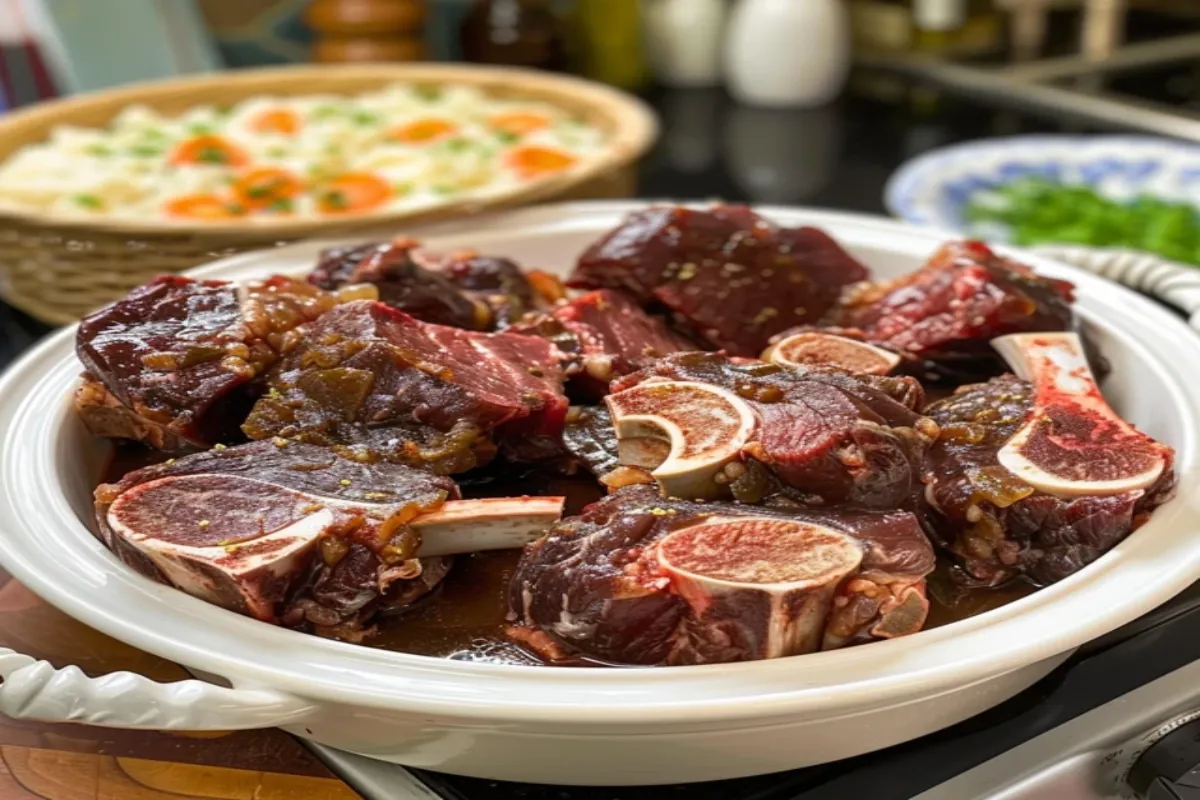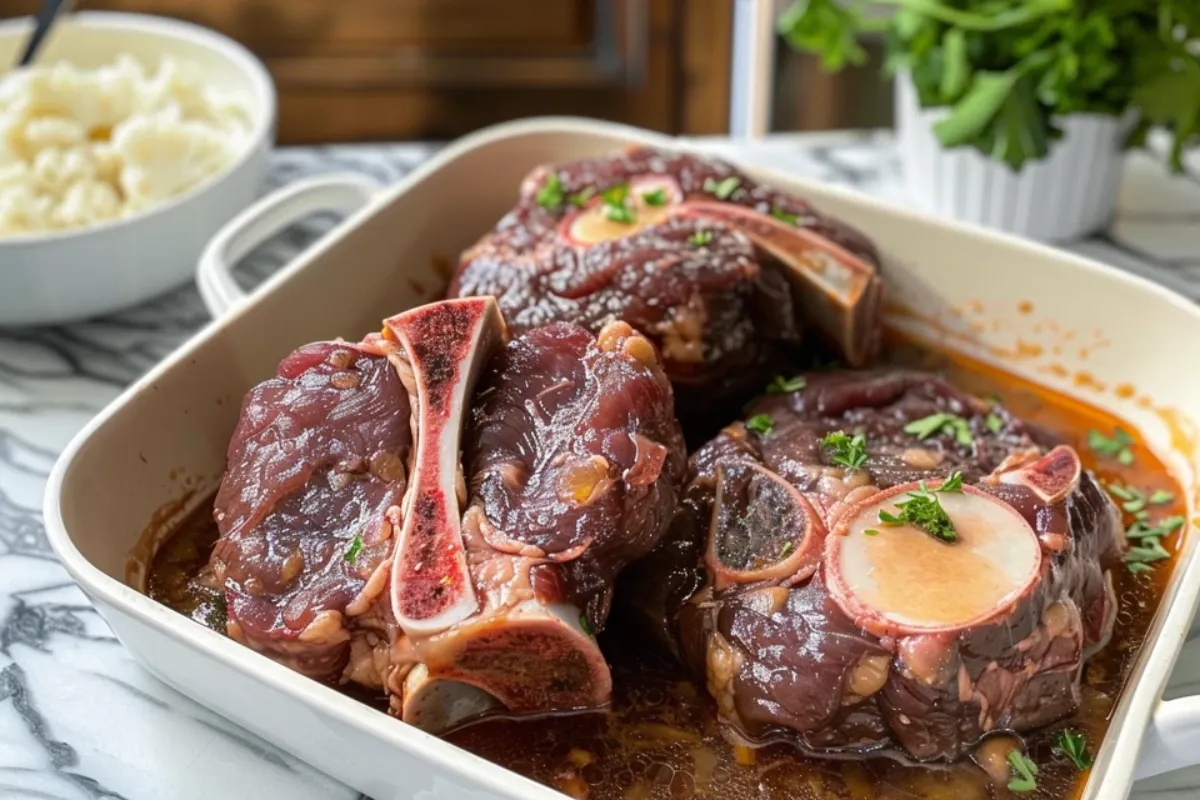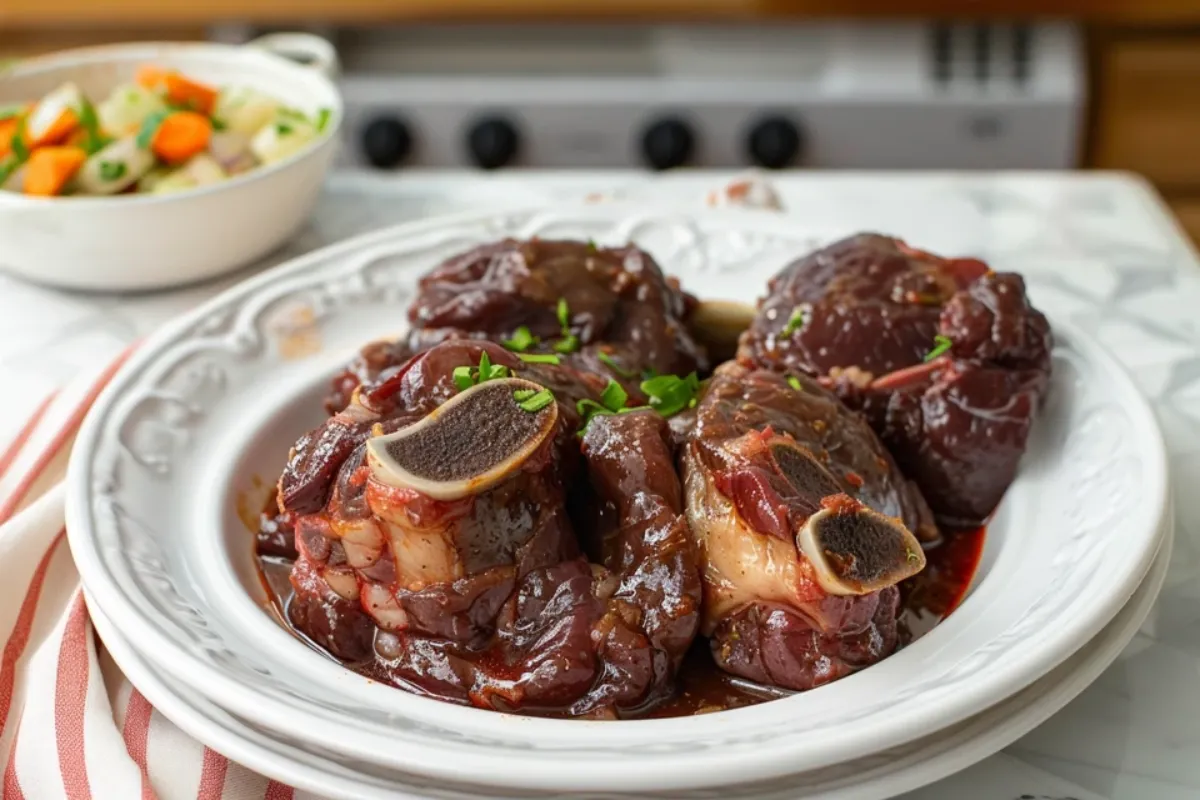Beef shin recipe, a flavorful and economical cut, has long been cherished in various cuisines for its depth of taste and versatility. Derived from the lower leg of the cow, this cut transforms into tender, melt-in-the-mouth dishes when cooked slowly. In this article, we delve into the culinary applications, nutritional benefits, and cooking techniques associated with beef shin.
Introduction
Beef shin, also known as beef shank, is a cut from the lower leg of the cow. Renowned for its rich flavor and gelatinous texture, it becomes exceptionally tender when subjected to slow cooking methods. This cut is a staple in numerous traditional dishes worldwide, offering both affordability and a robust taste profile.
1. Understanding Beef Shin
1.1 What is Beef Shin?
Beef shin comes from the foreleg of the cow. Due to the muscle’s extensive use, it contains a significant amount of connective tissue, making it ideal for slow cooking methods that break down these tissues into gelatin, resulting in a rich and flavorful dish.
1.2 Nutritional Profile of Beef Shin
Beef shin is a nutrient-dense cut, offering:
- Protein: Approximately 21.5g per 100g serving, essential for muscle growth and repair.
- Iron: Around 2.04mg per 100g, vital for oxygen transport in the body.
- Zinc: About 3.86mg per 100g, supporting immune function.
- Vitamin B12: Approximately 1.5µg per 100g, crucial for nerve function and red blood cell formation.
2. Culinary Applications of Beef Shin
2.1 Traditional Dishes Featuring Beef Shin
Beef shin is celebrated in various traditional dishes:
- Osso Buco: An Italian classic where beef shin is braised with vegetables, white wine, and broth, often served with gremolata.
- Beef Shin Rendang: A Malaysian dry curry that slow-cooks beef shin in coconut milk and spices until tender and flavorful.
- Beef Shin Stew: A hearty stew combining beef shin with root vegetables, slowly cooked to perfection.
2.2 Modern Interpretations
Contemporary chefs have embraced beef shin in innovative ways:
- Beef Shin Ragù: Slow-cooked beef shin in a rich tomato sauce, served over pasta or polenta.
- Beef Shin Tacos: Shredded slow-cooked beef shin used as a filling for tacos, topped with fresh salsa and avocado.
3. Cooking Techniques for Beef Shin
3.1 Braising
Braising involves searing the beef shin and then slow-cooking it in liquid. This method breaks down connective tissues, resulting in tender meat and a flavorful sauce.
Steps for Braising Beef Shin:
- Sear the Meat: Season and brown the beef shin on all sides in a hot pan.
- Prepare Aromatics: Sauté onions, garlic, and other desired vegetables.
- Deglaze the Pan: Add wine or broth to lift the flavorful bits from the bottom.
- Slow Cook: Return the meat to the pan, add sufficient liquid, and cook on low heat until tender.
3.2 Slow Cooking
Using a slow cooker allows for a hands-off approach, yielding tender beef shin over several hours.
Tips for Slow Cooking Beef Shin:
- Low and Slow: Cook on low heat for extended periods to break down connective tissues.
- Adequate Liquid: Ensure there’s enough liquid to cover the meat partially.
- Flavor Development: Incorporate herbs, spices, and vegetables to enhance the dish’s complexity.
4. Nutritional Benefits of Beef Shin
4.1 High-Quality Protein
Beef shin provides a substantial amount of high-quality protein, supporting muscle development and overall health.
4.2 Rich in Micronutrients
It is a good source of essential vitamins and minerals, including iron, zinc, and B vitamins, which play crucial roles in energy production, immune function, and neurological health.
4.3 Collagen Content
The high collagen content in beef shin contributes to joint health and may improve skin elasticity.
5. Selecting and Preparing Beef Shin
5.1 Choosing the Right Cut
When selecting beef shin, look for:
- Color: Bright red meat indicates freshness.
- Marbling: Some fat marbling enhances flavor.
- Bone-In vs. Boneless: Bone-in cuts add richness due to the marrow.
5.2 Preparation Tips
- Trimming: Remove any excessive fat or sinew.
- Marinating: Marinating can infuse additional flavors and aid in tenderization.
- Portioning: Cut into uniform pieces for even cooking.
6. Beef Shin in Global Cuisines
6.1 European Cuisine
In Europe, beef shin is often used in hearty stews and braises, such as the French Jarret de Boeuf, where it’s slow-cooked with vegetables and wine.
6.2 Asian Cuisine
In Asian cooking, beef shin features in dishes like Vietnamese Pho, where it’s simmered to create a rich broth, and Chinese red-cooked beef, a flavorful stew with soy sauce and spices.
7. Health Considerations
7.1 Fat Content
Beef shin is relatively low in fat compared to other cuts, making it a healthier option for those monitoring fat intake.
7.2 Caloric Value
With approximately 115 kcal per 100g serving, beef shin is a moderate-calorie option suitable for balanced diets.
8. Beef Shin Recipes
8.1 Classic Beef Shin Stew
Ingredients:
- 1kg beef shin, diced
- 2 onions, chopped
- 3 carrots, sliced
- 2 celery sticks, chopped
- 4 cloves garlic, minced
- 500ml beef stock
- 250ml red wine
- 2 bay leaves
- 1 sprig thyme
- Salt and pepper to taste
Instructions:
- Sear the Beef: In a large pot, brown the beef shin pieces on all sides.
- Sauté Vegetables: Add onions, carrots, celery, and garlic; cook until softened.
- Deglaze: Pour in red wine, scraping up any browned bits from the bottom.
- Combine Ingredients: Return the beef to the pot, add beef stock, bay leaves, and thyme.
- Simmer: Bring to a boil, then reduce heat, cover, and simmer for 2-3 hours until the meat is tender.
- Season:
12. Enhancing the Dining Experience with Beef Shin
12.1 Beverage Pairings
Pairing the right beverages can elevate the flavors of beef shin dishes. Consider the following options:
- Red Wine: A bold Cabernet Sauvignon or Malbec complements the rich flavors of braised beef shin.
- Beer: Dark ales or stouts add depth and pair well with the savory profile of beef shin stews.
- Non-Alcoholic Options: Sparkling water with a hint of lime or robust herbal teas can provide a refreshing contrast.
12.2 Perfect Side Dishes
Complement your beef shin recipes with these sides:
- Creamy Polenta: A rich and smooth pairing for ragù or braised beef shin.
- Roasted Root Vegetables: Carrots, parsnips, and potatoes add a rustic touch.
- Crusty Bread: Ideal for soaking up the flavorful sauces and juices.
13. Storing and Reheating Beef Shin
13.1 Proper Storage
- Refrigeration: Store cooked beef shin in an airtight container for up to 3-4 days.
- Freezing: Freeze leftovers in portion-sized containers for up to 3 months. Label and date the containers for easy tracking.
13.2 Reheating Tips
- On the Stovetop: Reheat gently over low heat to retain moisture and tenderness.
- In the Oven: Cover with foil and heat at 180°C (350°F) until warmed through.
- Microwave: Use a low setting to avoid drying out the meat.
14. Exploring Beef Shin in the Food Industry
14.1 Beef Shin in Restaurants
Modern restaurants are increasingly featuring beef shin in their menus, embracing its rich flavors and versatility in dishes like slow-cooked stews and ragù.
14.2 Beef Shin in Meal Kits
Meal kit services often include beef shin as a primary ingredient, allowing home cooks to experiment with slow-cooked recipes with minimal prep work.
14.3 Popularity in Home Cooking
The affordability and richness of beef shin make it a favorite among home cooks, particularly for family meals and special occasions.
This detailed exploration of beef shin not only highlights its culinary versatility but also emphasizes its nutritional benefits and cultural significance. Whether you’re a home cook or a professional chef, incorporating beef shin into your repertoire opens the door to an array of hearty, satisfying dishes that are sure to impress.
Conclusion
Beef shin stands out as a versatile, flavorful, and nutrient-rich cut of meat that deserves a place in every kitchen. Its affordability, combined with its ability to transform into tender, melt-in-the-mouth dishes through slow cooking, makes it a staple in traditional and modern cuisines alike. Whether you’re crafting a hearty stew, a luxurious ragù, or an innovative taco filling, beef shin offers endless possibilities for culinary creativity. By embracing this often-overlooked cut, you not only elevate your cooking but also contribute to sustainable and ethical food practices. So, the next time you’re planning a comforting meal, consider beef shin for its rich flavors, nutritional value, and undeniable charm.


